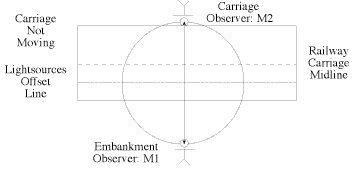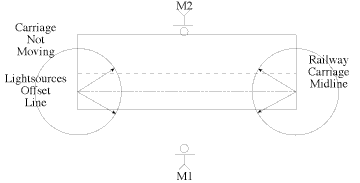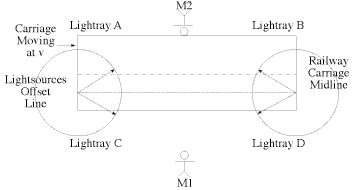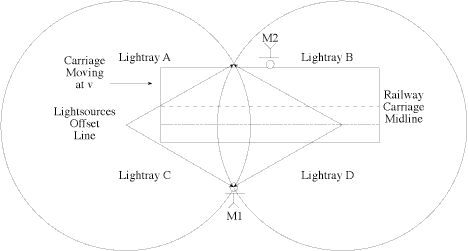The Einstein Railway System and the Speed of Light and the
Determinination of Simultaneity
Robert Howard Kroepel
Copyright © 2007
The Original Einstein Railway Drawing in Relativity on Page 25

This reasonable adaptation of the Einstein Railway Drawing is to be
used for comments inre the speed of light and simultaneity.
Einstein Railway 1
(Side View)
For clarity, M = M1 and M' = M2.
In the Einstein Railway 1 diagram, the Railway Carriage is not moving
relative to the Railway Embankment.
The possibility and probability is that the Railway Embankment and the
Railway Carriage while at rest relative to each other may in fact be in
motion relative to some other physical phenomena.
The most logical physical phenomena to which the Embankment and the
Carriage would be in relative motion would be the speed of light, which
is c or 186,000 in vacuo, in
the absence of other physical phenomena which could alter the speed
or/and the direction of a lightray or a lightwave or a lightsphere.
There is no illogic in concluding (1) that there is an absolute
velocity (AV) which is the speed of light, c, at 186,000 mps, in vacuo, (2) that when a lightray
"goes past" the center of mass (CoM) of any object at c/186,000 mps
then the object is—objectively—at AV = 0 mps and therefore at absolute
rest (AR) in the absolute rest reference frame (ARRF), and (3) when an
object is motion—when an object has been accelerated from AR, then the
object's AV = > 0 mps < c.
This phenomenon is theoretically observable only by a Perfect Observer
who/which is "independent of the state of motion of [its] body of
reference" (his/her/its rate of perception never varies with
accelerations and decelerations) and who/which therefore measures
space-distances with identical invariable space-intervals on the
Perfect Ruler and time-durations with identical invariable
time-intervals in the Perfect Clock and who/which uses the Perfect
Camera which creates 3-D holograms by sending out detection waves which
travel instantaneously to and from all objects and events and therefore
records the exact objective spatial and temporal relationships of the
objects and events. The 3-D hologram record would enable the Perfect
Observer to determine the position and momentum of any and all
particles, atoms, molecules, etc., and thereby determine the past
record, the present record, and future records of the positions and
momentum and any and all particles, atoms, molecules, etc., i.e., the
determinism and predictability of the universe would be 100% complete
and observable to the Perfect Observer.
Perfect Observers exist only in thought experiments, yet, as
theoretical concepts, they reveal the actual principles of physical
phenomena and therefore physical reality.
If the Embankment and Carriage when at rest relative to each other have
an AV relative to the speed of light, wherein their AV > c when
moving in the direction of motion of lightrays or AV = > c when
moving opposite the direction of motion of lightrays, an assumption
that is not illogical can be made that for determining the simultaneity
of events via the Einstein Railway System lightrays will "go past" the
centers of mass of observers, embankments and carriages at rest
relative to each other at c/186,000 mps.
This assumption permits considering the speed of light "going past" M1
and the embankment to be c and the relative velocity, v, between the
Embankment and the Carriage, to be used for the determination of
simultaneity.
The Einstein Railway System assumes that the Carriage is in motion
relative to the Embankment.
How did the Carriage assume a motion relative to the Embankment?
The logical answer herein, as observed when humans make railway
carriages and accelerate them over embankments, is that the Carriage at
one timepoint was at rest relative to the embankment and was
subsequently accelerated relative to the Embankment.
This answer has to be considered to be a fact which has to be part of
the knowledge bases of both M1 and M2. Both M1 and M2 know the Carriage
has been accelerated. If M1 and M2 are physicists, then they would also
know that when an object is accelerated or decelerated its kinetic
mass-energy changes and its rate of operation therefore changes, e.g.,
inre clocks, the change in the clocks' kinetic mass-energy would cause
a change of their time-interval, rate of ticking, and timepoints upon
their timelines.
M1 and M2 would have to know that relative to the Embankment Lightrays
A and B would "go past" M2's head at c when the Carriage is at rest and
at either c-v or c+v when the Carriage is in motion after acceleration.
M1 and M2 would then have to realize that, objectively, Lightrays A and
B could not possibly "go past" M2's head at c and that any perception,
observation or measurement M2 would have of Lightrays A and B "going
past" him/her at c would have to be an illusion and not a reality.
M1 and M2 are the same height.
M1 and M2 are equidistant from the front and the back of the Carriage.
M1 and M2 are perpendicular to each other.
M1 is standing upon a railway station platform at the same
height above the railway embankment as height of the floor of the
railway carriage: M1 and M2 are perpendicular to each other and at the
same height above the railway embankment.
Lightsources are located at each end of the railway carriage: the
Lightsources are at the same height—the height of the heads of M1 and
M2—above the railway carriage's floor
and the railway station's platform. Lightrays emitted from the
Lightsources would strike the heads of M1 and M2.
The Lightsources are offset from the railway carriage's
midline.
Einstein Railway 1A
(Overhead View)
M1 is offset from the Lightsources' offset line the same
distance as M2 is offset from the Lightsources' offset line: M1 ->
Lightsources' Offset Line = M2 -> Lightsources' Offset Line.
If the railway carriage were not moving and a Lightsource was triggered
from the spacepoint on the Lightsources' offset line at which M1 and M2
are perpendicular to each other, the Lightsphere emitted (represented
by the circle in the diagram) would strike M1 and M2 simultaneously (at
the same timepoint).
Einstein Railway 2
(Side View)
If Lightrays A and C were emitted from a Lightsource at the back of the
Carriage
simultaneously with Lightrays B and D emitted from a Lightsource at the
front
of the Carriage, then, considering the length or distance traveled,
Lightray
A = Lightray B = Lightray C = Lightray D.
Einstein Railway 2A
(Overhead View)
All Lightrays are emitted as spherical waves which can be
represented as circles in the diagrams: the Lightrays would therefore
be emitted from the centers of their Lightspheres, and because all
Lightrays are emitted simultaneously then all Lightsphere radii would
be equal, therefore the distances traveled by all Lightrays would be
identical.
When the Carriage is at rest/not in motion relative to the Embankment,
and when assuming that their AV = 0 mps, then Lightrays A and B would
therefore go past M2's center of mass (CoM) at
c/186,000 mps,
and past M1's CoM at c/186,000 mps.
Timepoint T0
Einstein Railway 3
(Side View)
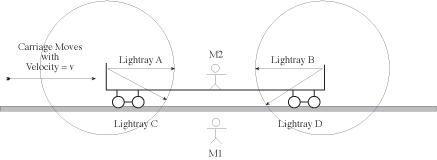
Einstein Railway 3A
(Overhead View)
In the Einstein Railway 3 and 3A diagrams, at Timepoint T0, the
Carriage is moving with velocity v over the
Embankment
and past M1, M2 is therefore moving with velocity v, M1 and M2 are
perpendicular to each other; Lightrays A, B, C, and
D are emitted simultaneously from their Lightsources and therefore
travel over equal distances represented by the equal radii of their
Lightspheres.
The velocities of all Lightrays are independent of the motion of their
Lightsources,
and, therefore, all Lightrays are traveling at c.
Timepoint T1
Einstein Railway 4
(Side View)
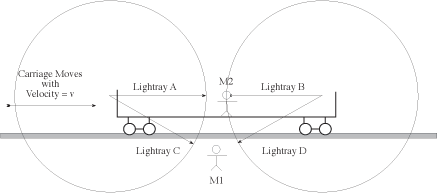
Einstein Railway 4A
(Overhead View)
In the Einstein Railway Diagrams 2 and 2A, the carriage is continuing
to move, and at Timepoint T1, which is of a short enough duration from
T0 that the
Lightrays
do not go past M1 or M2,
1. Lightray A's length/distance
traveled = Lightray B's length/distance traveled,
2. Lightray C's length/distance traveled = Lightray D's length/distance
traveled,
3. M2 has moved a distance away from M1 and towards Lightray B,
4. Lightray B therefore strikes M2 ahead of, before, and therefore
non-simultaneously
inre, Lightray A,
5. M2 reports Lightrays A and B did not strike him simultaneously and
concludes
they were not emitted simultaneously.
The report of M2 cannot occur as stated unless M2 is moving with a
velocity v
relative
to not only to the Embankment but also relative to the Lightrays A and
B.
Lightrays A and B are theoretically moving at c = 186,000 mps. The
speed of light is not affected by the motion of a lightsource; the
speed of light is independent of the state of motion of the body of
reference of a lightsource.
M1 perceives and thereby observes Lightray A goes past M2's center of
mass (CoM) at c-v and Lightray B goes past
M2's CoM at c+v.
Any report from M2 of a perception or an observation that Lightrays A
and B are going past M2's
CoM at c and not at c-v or c+v is therefore in reality a report of M2's
illusion, M2's
moving observer's illusion (MOI).
Timepoint T2
Einstein Railway 5
(Side View)

Einstein Railway 5A
(Overhead View)
At Timepoint T2, Lightrays C and D strike M1; M1 reports Lightrays C
and
D have struck him simultaneously (at the same timepoint, Timepoint 2).
M1 observes Lightrays C and D continue to go past his CoM at c and
Lightray A goes past M2's CoM at c-v while Lightray B goes past M2's
CoM at c+v.
For simultaneity, the Einstein Railway System requires (1) that events
or Lightsources be equidistant from a single observer (M1) at rest
relative to the events or Lightsources, (2) the events or Lightsources
lie in a perfectly straight line parallel to the directions of motion
of light rays—events are automatically non-simultaneous when they are
not equidistant from the single observer, and (3) the lightrays from
the events strike the single observer at the same instant or
timepoint—events are automtically non-simultaneous when lightrays from
them do not strike the single observer at the same instant or timepoint.
Imagine that there are identical synchronized clocks which have the
same time-intervals which generate identical rates of ticking and
identical timepoints and identical timelines and are placed near enough
to the Lightsources that light-based information transmission delays
were negligible; imagine that when the Lightrays were emitted
simultaneously, each clock triggered a companion camera that
photographed the Lightray emissions and time-stamped the photos.
Whenever the Lightrays were emitted, the timestamps would all be
identical.
The current definition of simultaneity
is two or more events occurring at the same timepoint.
http://en.wikipedia.org/wiki/Simultaneity
Simultaneity
From Wikipedia, the free encyclopedia
Simultaneity is the property of two events happening at the same time
in at least one reference frame.
The Oxford Dictionary of Physics
Alan Isaacs, ed.
Oxford University Press, Fourth Edition, 2000
simultaneity The condition in
which two or more events occur at the same instant.
Because the time-stamped photos could be
examined by M1 or M2 at any spacepoint at any timepoint and the
information inre the time-stamps would be identical for both M1 and M2,
then M1 and M2 could agree that the identical time-stamps on the photos
prove the photos were taken at the same timepoint and that the events
which were the emissions of the Lightrays were all simultaneous.
Thus, when simultaneity is defined as two or more events occurring at
the same timepoint, simultaneity is thus relevant to time and is
independent of geometry or geography.
Here is an operational definition of time:
Time is the use of a duration, which is
a time-interval, and which is modeled after a physical periodic or
cyclic motion, as a unit of measurement of the occurrences of events,
which are relationships between or among people, organisms, and/or
objects comprised of matter and/or energy, or for the measurement of
the duration of a single event, for predicting, coordinating,
scheduling, or synchronizing events, for the determination of the
simultaneity of events, or for the determination of the causality or
coincidence between or among people, organisms, and/or objects.
Object = Group of particles/atoms/molecules which retains its
organization and unity and identity for a longer duration than a
relevant event.
Event = A causal relationship between/among people/organisms/objects.
Causality = People/Organisms/Objects/Events who/which are comprised of
matter/energy and who/which are causes and who/which cause the effects
which are (A) changes of inertial states in pre-existing
people/organisms/objects/events or (B) new
people/organisms/objects/events.
The causal sequence is (1) cause(s) -> (2) effect(s)
Note that in a causal sequence the causes do not exist as causes at the
same time/at the same timepoint as the effects exist as effects; a
causality is observed to occur abefore and during one timepoint after
which the effects are observed.
Coincidence = The appearance at the same timepoint of
people/organisms/objects/events who/which are not causally related.
Note that in a coincidence the relevent people/organisms/objects/events
may appear (A) simultaneously, which is to appear at the same
timepoints, (B) sequentially at contiguous timepoints, or (C)
overlapping at some timepoints but not others.
People/organisms/objects/events are thus related either by being causal
or coincidental.
Simultaneity = Two or more events occurring at the same timepoint on
the same timeline/timemap.
Because simultaneity involves timepoints, only a time system which uses
time-intervals/TIs to generate a clock's rate of ticking/RoT and
therefore a set of timepoints on a timeline can be used to determine
simultaneity.
The essence of time is the time-interval/TI which is the unit of
measurement of time.
The TI in a clock generates the clock's rate of ticking/RoT, set of
timepoints and timeline (the set of timepoints fits upon the timeline).
There are two TIs: (1) The variable time-interval/VTI which is found in
variable time-interval clocks/VTICs whose rates of ticking/RoTs are
variable/not constantchanged by, and not adjusted to compensate for,
the inverse effects caused by accelerations/decelerations; (2) The
invariable time-interval/ITI which is found in invariable time-interval
clocks/ITICs whose RoTs are invariable/constant because they are
adjusted to compensate for the inverse effects caused by
accelerations/decelerations.
There are two types of clocks: (1) The variable time-interval
clock/VTIC whose TI is a VTI because the VTIC's RoT is variable/not
constant because it is not adjusted to compensate for the inverse
effects caused by accelerations/decelerations; (2) the invariable
time-interval clock/ITIC whose TI is an ITI because the ITIC's RoT is
invariable/constant because it is adjusted to compensate for the
inverse effects caused by accelerations/decelerations.
There are two types of ITICs:
(1) The motion-sensing self-adjusting invariable time-interval
clock/MSSAITIC whose ITI is created by
the process which by accelerometers/decelerometers sense changes of
motion/velocity caused by acceleratons/decelerations and a computer
adjusts the TI to make it an ITI;
(2) The master invariable time-interval clock/MITIC, which sends radio
signals to control slave invariable
time-interval clocks/SITICs found in
different inertial reference frames/IRFs.
LT = Local Time = Time measured by local time-intervals/LTIs in local
time clocks/LTCs in individual IRFs.
Events occurring within an IRF can be measured by VTIs in VTICs
provided that the VTIs are identical and thereby generate identical
timepoints which generate identical timelines/timemaps for each VTIC;
events occurring within an IRF are not required to lie in a straight
line--they can be in any positions/locations within the IRF.
AT = Absolute Time/AT = Time measured by absolute time-intervals/ATIs
in absolute time clocks/ATCs
in any IRFs.
Events occurring within different IRFs can be measured by ITIs in ITICs
provided the ITIs are identical and thereby generate idential
timepoints which generate identical timelines/timemaps for each ITIC;
events occurring in different IRFs are not required to lie in a
straight line--they can be in any positions/locations with the IRFs.
The Law of Inertia: An object which has an inertial state of (A) being
at rest or or (B) being in uniform motion will retain its inertial
state of being at rest or in uniform motion until acted upon by a force.
At Rest = Having no velocity or direction
Uniform Motion = No change of direction or velocity
Velocity = Speed + Direction
Force = A push or a pull
Corollaries to the Law of Inertia:
1. A force is the cause of a change of an inertial state.
2. The observance of a change of an inertial state implies the cause to
be a force of some kind.
Inertial Reference Frame = Condition of having the same velocity
Forces which accelerate/decelerate people/organisms/objects cause those
people/organisms/objects to leave one inertial reference frame and
enter into a different inertial reference frame; thus, the common link
between inertial reference frames is the velocity of the
people/organisms/objects.
People/organisms/objects have fundamental rates of operation,
functioning, vibration, frequency, metabolism, perception, ticking, etc.
These fundamental rates change inversely with accelerations and
decelerations.
In each specific reference frame, a person has a specific rate of
metabolism and a specific rate of perception, an organism has a
specific rate of metabolism, an object has a specific rate of
operation, rate of functioning, rate of vibration, frequency, and a
clock has a specific rate of ticking and therefore a specific
time-interval, timepoints and timeline.
Every occurrence in which a person/organism/object returns to a
specific reference frame—when the person/organism/object is accelerated
or decelerated to a previous speed, then the person assumes his/her
previous rate of metabolism and rate of perception, the organism
assumes its previous rate of metabolism, an object assumes its previous
rate of operation/functioning/vibration/frequency/etc., and a clock
assumes its previous rate of ticking.
If time-intervals were invariable, never varying despite accelerations
or decelerations of their host clocks, then those invariable
time-intervals would generate identical rates of ticking of their host
clocks and identical timepoints on identical timelines and therefore
would be "independent of the state of motion of [their bodies] of
reference" (their host clocks) and they would measure absolute time and
the identical timepoints they generated would determine the absolute
simultaneity of events in different reference frames (on different
bodies of reference).
Can humans design and build invariable time-intervals?
Yes, by designing and building clocks whose mechanisms are adjusted to
compensate for the known effects on the rates of operation/ticking of
the mechanisms of clocks caused by accelerations and decelerations.
What are the known effects on the rates of operation/ticking of the
mechanisms of clocks caused by accelerations and decelerations?
Accelerations cause increases in the kinetic mass-energy of an
accelerated object.
This increase in kinetic mass-energy makes the mechanism of an
accelerated clock more resistant to changes of motion and therefore
"heavier" inre the energy available to make the clock's escapement
mechanism (which converts the energy available to power the escapement
mechanism into a cyclic change of motion which defines the "tick" and
the "tock" of a clock's rate of ticking and which thereby causes the
clock's mechanism to operate.
If the energy available to make the clock's escapement mechanism
operate, then the "heavier" mechanism, which is more resistant to a
change of motion, will slow down.
The slowing down of the rate of operation of an accelerated clock's
escapement mechanism caused by an increase in the mechanism's
kinetic mass-energy caused by accelerations will result in a slowing
down of the clocks rate of ticking

